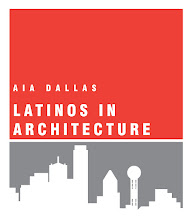 |
| From left to right: Marcel Erminy, Juan Sosa, Santos Catalan, David Zatopek, AIA, Sebastian Morande, Lorena Toffer, AIA, Robert Casasus, Lorena Perez, Miguel Roldan, Jeff Potter, FAIA, Clemente Jaquez, AIA, Robert Casstevens at the Latino Cultural Center plaza |
The intent of the evening was to discuss cultural relevance in design and innovation, all while enjoying great food and mixers by the Latino Culinary Institute. As our guest of honor, Miguel Roldan discussed his ideas and projects, which are very exciting and interesting – particularly because he evokes a feeling of relevance. By that I mean that each work tends to go further beyond the programmatic function of the building. There is an essence that the project wants to engage with its place and its people. Whether we are talking about the dynamics of how economical means of construction offer unique opportunities, to substantive ideas of encouraging cultural trends in society.
During our discussions at the Latino Cultural center, some of the topics were general in nature, but there were particular questions that generated great debate and even questioned our profession. There is something to be said about architecture that is innovative because of its use of material and its unique interpretation of space, but when you design for a deeply rooted culture - how do you advance architecture? How do you translate tradition and customs into our contemporary world and through what language? Words like sophisticated, strategy and performance may not be so fitting when in essence some people just want what they have known and experienced for all their life – whether that is a preference of color, material or space arrangement. And to this we answered YES! Yes Architecture can respond and adapt culture to our changing environment, but understanding how this can be done has to go beyond textbooks and Google searches. We must avoid, in a subliminal or subconscious manner, our intuitive desire to drive projects in any one direction; we must engage and become entangled in order to express culturally significant Architecture.
I love to travel, I have been to many places in Europe, Asia and the Americas. One of my dearest
memories, is of my Grandpa’s town in the Mountainous regions of Chihuahua, Mexico. There, a small
village can only be accessed through a small winding, unpaved road. Dangerous you might say? Yes! But
genuine and unique to the way people live there. As you enter the ranch, you access a different world. Many houses are still made of Adobe Clay bricks and timber, there are no paved roadways, and everyone in the town knows each other. My Grandpa’s house sits atop a hill overlooking the town, and a rock trail from the house leads you to a crystal-clear stream just 200 feet away. The air is fresh and the sun embraces you with light and warmth. There is something very innocent about this place that words and actions such as “innovation”, “progress”, “technology” are a detriment to its very existence.
Denoting the importance of this anecdote, it is hard to conceive that Architecture become so worldly that we are in essence creating a homogenous language across the world. I do not believe we want society to be defined, in a way, by global expectations and a certain architectural language, which in case devalue the richness of context. When we visit places across the globe, we expect a unique experience, at least different than what we see at home. In places where there is great economic advancement, it will be crucial to take a moment of reflection and contemplation.
Simply said, culture in architecture is relevant. It is not about googling context and typing in the country's history in the web. It is about connecting with people, understanding customs and tradition.
Some values are just intangible and some architecture aspects of culture, like great family recipes, are passed down from generations. We must tap into this to enhance and promote our identity as a society and individuals.
Clemente Jaquez, AIA
AIA Dallas LiA 2013 Committee Chair











